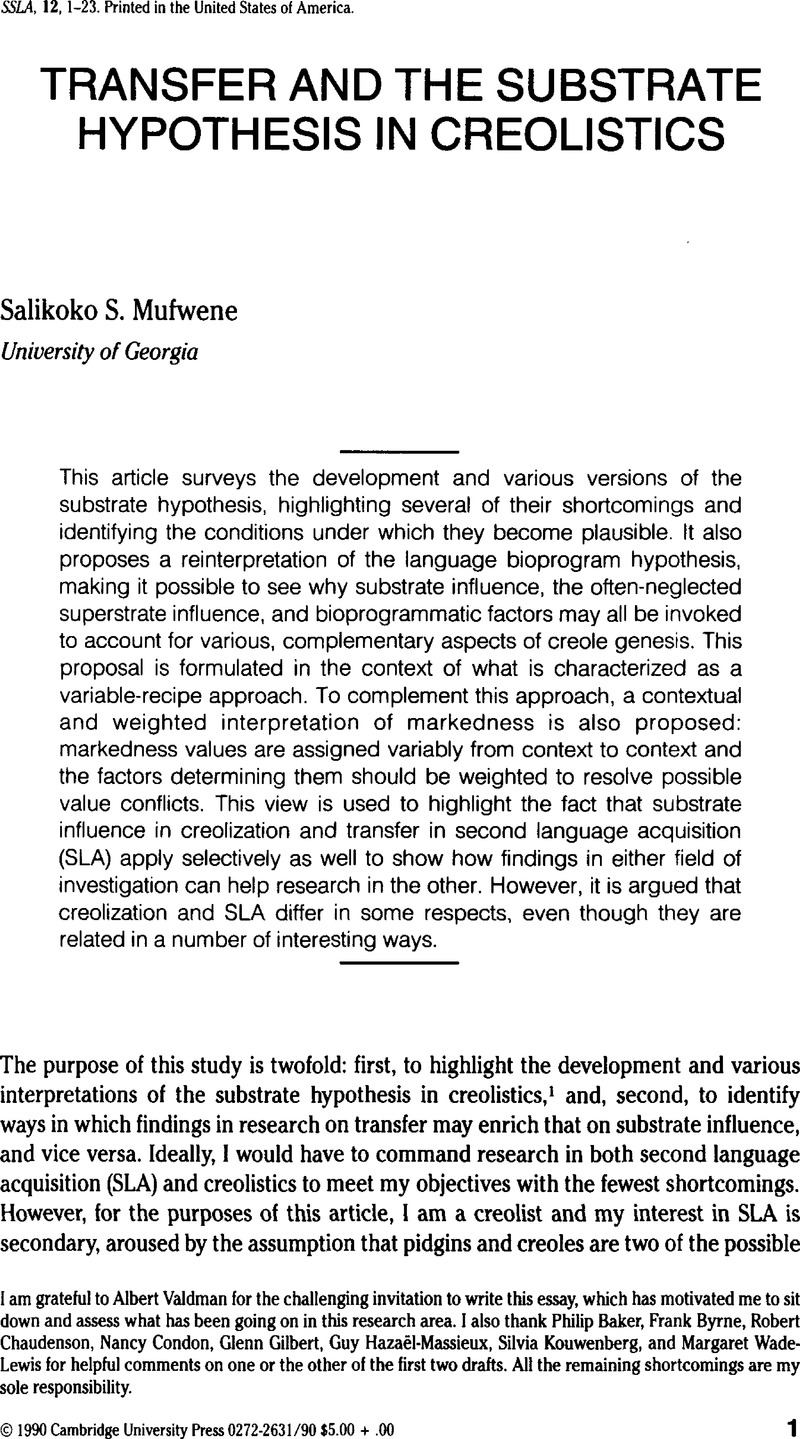Crossref Citations
This article has been cited by the following publications. This list is generated based on data provided by Crossref.
Kouwenberg, Silvia
1992.
From OV to VO linguistic negotiation in the development of Berbice Dutch creole.
Lingua,
Vol. 88,
Issue. 3-4,
p.
263.
Odlin, Terence
1992.
Transferability and linguistic substrates.
Interlanguage studies bulletin (Utrecht),
Vol. 8,
Issue. 3,
p.
171.
Wade-Lewis, Margaret
1993.
The Status of Semantic Items from African Languages in American English.
The Black Scholar,
Vol. 23,
Issue. 2,
p.
26.
MUFWENE, SALIKOKO S.
1994.
SOUTH AFRICAN INDIAN ENGLISH.
World Englishes,
Vol. 13,
Issue. 3,
p.
425.
Wekker, Herman
1996.
Creole Languages and Language Acquisition.
Major, Roy C.
and
Faudree, Michael C.
1996.
Markedness Universals and the Acquisition of Voicing Contrasts by Korean Speakers of English.
Studies in Second Language Acquisition,
Vol. 18,
Issue. 1,
p.
69.
Tagliamonte, Sali A.
1999.
Review of Bayley & Preston (1996): Second language acquisition and linguistic variation.
Journal of Pidgin and Creole Languages,
Vol. 14,
Issue. 2,
p.
385.
Apter, Andrew
2002.
On African Origins: Creolization and Connaissance in Haitian Vodou.
American Ethnologist,
Vol. 29,
Issue. 2,
p.
233.
Mufwene, Salikoko S.
and
Pargman, Sheri
2003.
Competition and Selection in the Development of American Englishes.
World Englishes,
Vol. 22,
Issue. 4,
p.
367.
Lefebvre, Claire
2003.
Yearbook of Morphology 2002.
p.
35.
Odlin, Terence
2003.
The Handbook of Second Language Acquisition.
p.
436.
Clachar, Arlene
2005.
Creole English Speakers’ Treatment of Tense‐Aspect Morphology in English Interlanguage Written Discourse.
Language Learning,
Vol. 55,
Issue. 2,
p.
275.
Valdman, Albert
2005.
REVIEW ARTICLE.
Studies in Second Language Acquisition,
Vol. 27,
Issue. 3,
p.
441.
Moro, Anna L.
2007.
An exploration of colour terms in English-lexifier Atlantic creoles.
Lingua,
Vol. 117,
Issue. 8,
p.
1448.
Véronique, Daniel
2009.
Classes lexicales et développement grammatical dans la variété de base des apprenants de français l2 et dans le développement des créoles français.
Acquisition et interaction en langue étrangère,
p.
227.
Szmrecsanyi, Benedikt
and
Kortmann, Bernd
2009.
The morphosyntax of varieties of English worldwide: A quantitative perspective.
Lingua,
Vol. 119,
Issue. 11,
p.
1643.
Lucchesi, Dante
N. Baxter, Alan
and
Ribeiro, Ilza
2009.
O Português Afro-Brasileiro.
Sprouse, Rex A.
2009.
Creoles and interlanguages, conclusions and research desiderata: a reply to Plag.
Acquisition et interaction en langue étrangère,
p.
283.
Mufwene, Salikoko S.
2010.
SLA AND THE EMERGENCE OF CREOLES.
Studies in Second Language Acquisition,
Vol. 32,
Issue. 3,
p.
359.
Véronique, Georges-Daniel
2013.
Sociolinguistique du contact.
p.
143.


